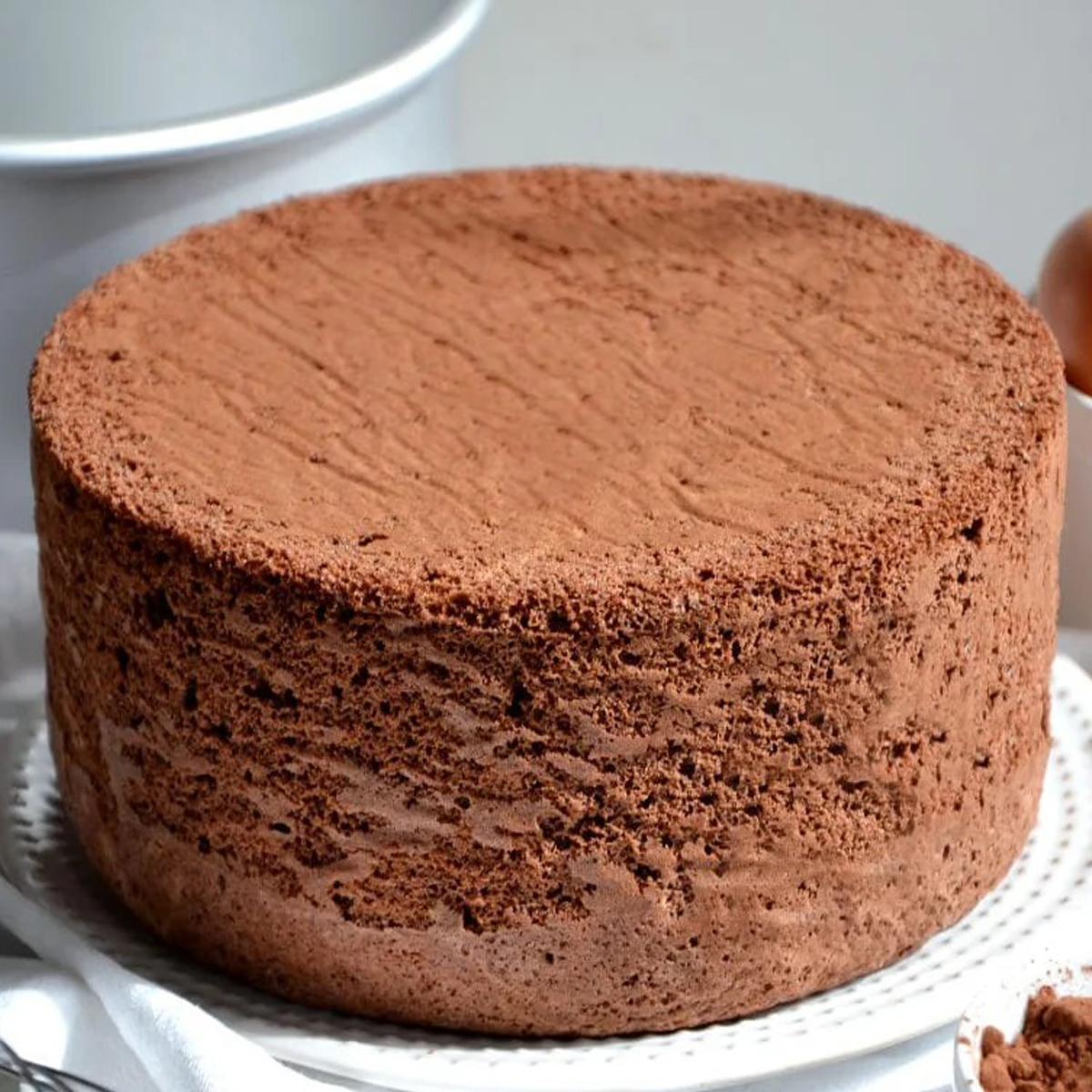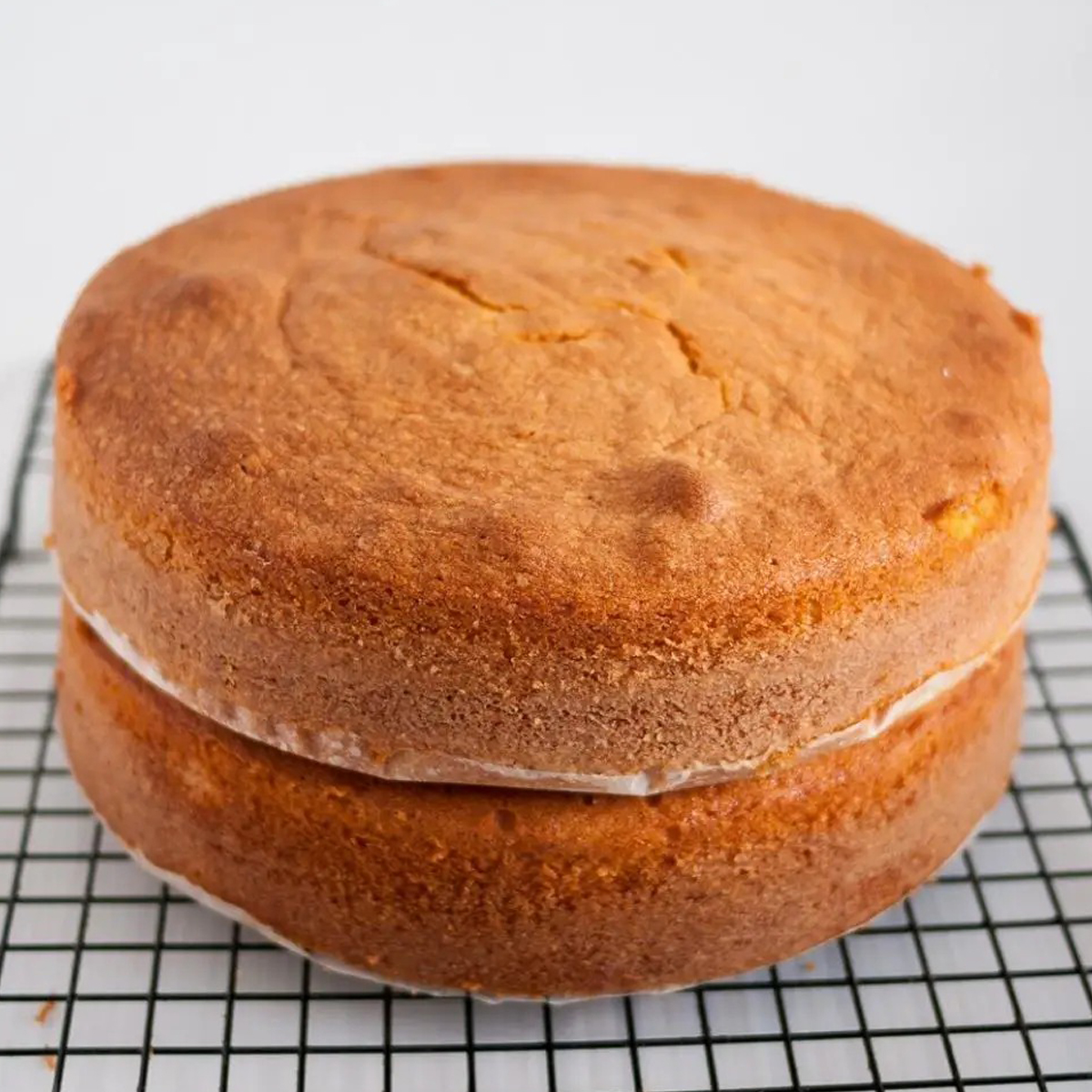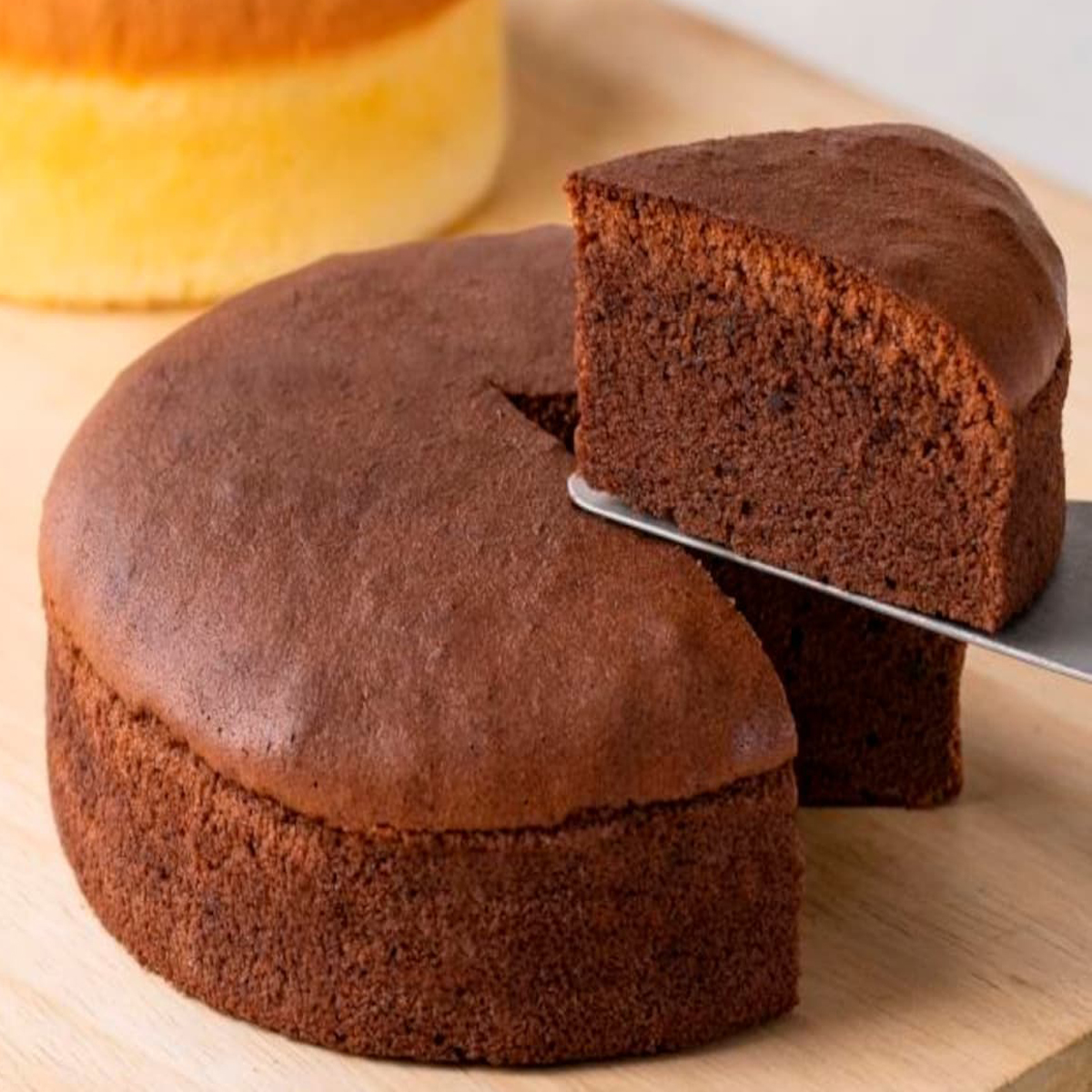Lemon Sponge Cake is a delightful dessert known for its light, airy texture and vibrant citrus flavor. This classic cake is a harmonious blend of zesty lemon zest and juice, complemented by a tender and fluffy sponge-like crumb. It’s a dessert that embodies the perfect balance between sweet and tangy, making it a refreshing and invigorating treat, especially during warm seasons. Whether enjoyed on its own, drizzled with a lemon glaze, or paired with a dollop of whipped cream and fresh berries, Lemon Sponge Cake is a timeless favorite that brightens any occasion with its sunny and delightful taste.

What Is Lemon Sponge Cake?
Lemon Sponge Cake is a type of cake known for its light, airy, and spongy texture, which is achieved through the use of whipped egg whites. The key characteristic of this cake is its vibrant lemon flavor, derived from the inclusion of lemon zest and lemon juice in the batter.
Here are the primary components of a Lemon Sponge Cake:
- Eggs: The recipe typically calls for whole eggs that are separated into yolks and whites. The egg whites are whipped to stiff peaks to create the cake’s airy texture.
- Lemon Zest: The outer, flavorful layer of lemon peel is grated to provide the cake with its intense lemon aroma and taste.
- Lemon Juice: Freshly squeezed lemon juice adds both tartness and a bright citrus flavor to the cake.
- Flour: All-purpose flour is used as the base ingredient for the cake batter.
- Sugar: Granulated sugar is used to sweeten the cake.
- Baking Powder: Baking powder or a combination of baking powder and baking soda is used as a leavening agent to help the cake rise.
- Salt: A pinch of salt enhances the overall flavor of the cake.
- Optional Flavorings: Some recipes may include additional flavorings like vanilla extract for added depth of flavor.
The preparation of Lemon Sponge Cake involves whipping the egg whites until stiff peaks form, and then gently folding them into the batter to create a light and airy texture. The lemon zest and juice are added to infuse the cake with a refreshing citrus flavor.
Lemon Sponge Cake can be served plain or adorned with various toppings or fillings, such as lemon glaze, powdered sugar, whipped cream, fresh berries, or even a lemon curd filling. It’s a versatile dessert suitable for various occasions, from casual gatherings to elegant celebrations. Its bright lemony taste makes it a popular choice, especially during the spring and summer months.

Why You Will Love Lemon Sponge Cake Recipe?
- Refreshing Citrus Flavor: The Lemon Sponge Cake bursts with the bright and tangy taste of fresh lemons. It’s a burst of sunshine in every bite.
- Light and Airy Texture: Thanks to whipped egg whites, this cake has a wonderfully light and airy texture that practically melts in your mouth.
- Versatile Dessert: Lemon Sponge Cake can be enjoyed in various ways. You can savor it on its own, pair it with fresh fruit, dress it up with lemon glaze, or use it as a base for more elaborate desserts like trifles or layered cakes.
- Perfect for All Occasions: Whether you’re celebrating a special occasion or simply craving a delicious treat, Lemon Sponge Cake is versatile enough to suit any event.
- Great for Tea Time: It’s an ideal choice for afternoon tea, and it pairs wonderfully with a cup of hot tea or coffee.
- Simple and Elegant: The recipe is relatively simple, making it accessible to both novice and experienced bakers. Yet, its elegant appearance makes it suitable for more formal gatherings.
- Summer Favorite: Lemon Sponge Cake is particularly popular during the warmer months due to its refreshing and uplifting flavor profile.
- Customizable: You can personalize your Lemon Sponge Cake by adjusting the level of lemon flavor, sweetness, and even experimenting with different toppings and fillings.
- Time-Tested Classic: It’s a classic dessert that has stood the test of time, loved by generations for its timeless appeal.
- Crowd-Pleaser: Lemon Sponge Cake tends to be a crowd-pleaser. Its bright and zesty flavor appeals to a wide range of tastes.
- Homemade Goodness: Baking a Lemon Sponge Cake from scratch allows you to enjoy the aroma and satisfaction of homemade desserts.
In summary, the Lemon Sponge Cake recipe offers a delightful combination of fresh citrus flavor, a light and airy texture, and versatility that makes it perfect for any occasion. Whether you’re a lemon lover or simply in search of a delightful dessert, this recipe is sure to become a favorite in your repertoire.

Ingredients For Lemon Sponge Cake
For the Lemon Sponge Cake:
- 4 large eggs, separated into yolks and whites
- 1 cup (200 grams) granulated sugar, divided
- 1 teaspoon lemon zest (from about 1-2 lemons)
- 3 tablespoons fresh lemon juice (from about 1-2 lemons)
- 1 cup (120 grams) all-purpose flour
- 1/2 teaspoon baking powder
- 1/4 teaspoon salt
For the Optional Lemon Glaze:
- 1 cup (120 grams) powdered sugar (confectioners’ sugar)
- 2-3 tablespoons fresh lemon juice
- Lemon zest for garnish (optional)
These quantities are standard and can yield a delicious Lemon Sponge Cake. However, you can adjust the level of lemon flavor and sweetness to your preference. If you want a more intense lemon taste, you can add more lemon zest or juice. Similarly, you can vary the amount of sugar in the cake and glaze to suit your sweetness preference.
Once you’ve gathered all the ingredients and quantities, follow your chosen Lemon Sponge Cake recipe for step-by-step instructions on how to prepare and bake this delightful dessert.
How To Make Lemon Sponge Cake
For the Lemon Sponge Cake:
- Preheat your oven to 350°F (175°C). Grease and flour a 9-inch (23 cm) round cake pan or line it with parchment paper for easy removal.
- In a large mixing bowl, beat the egg yolks and half of the granulated sugar until the mixture is pale and creamy.
- Stir in the lemon zest and lemon juice into the egg yolk mixture. Mix until well combined.
- In a separate bowl, whisk together the all-purpose flour, baking powder, and salt.
- Gradually add the dry ingredients to the egg yolk mixture, mixing until just combined. Do not overmix; it’s okay if there are a few lumps.
- In another clean bowl, use an electric mixer to beat the egg whites until they form stiff peaks.
- Gently fold the whipped egg whites into the batter in two or three additions until no white streaks remain, being careful not to deflate the mixture.
- Pour the batter into the prepared cake pan and smooth the top evenly.
- Bake in the preheated oven for approximately 25-30 minutes, or until the cake is golden brown and a toothpick inserted into the center comes out clean.
- Remove the cake from the oven and let it cool in the pan for about 10 minutes. Then, transfer it to a wire rack to cool completely.
For the Optional Lemon Glaze:
- In a small bowl, combine the powdered sugar and 2-3 tablespoons of fresh lemon juice. Adjust the amount of lemon juice to achieve your desired glaze consistency.
Assembly and Garnish:
- Once the cake has cooled completely, drizzle the lemon glaze over the top. If desired, garnish with additional lemon zest for a pop of color and flavor.
- Slice and serve your delicious homemade Lemon Sponge Cake. Enjoy!
This formula provides step-by-step instructions for creating a classic Lemon Sponge Cake with an optional lemon glaze for added flavor and sweetness.

How To Serve Lemon Sponge Cake
- Cool and Slice: Ensure that the Lemon Sponge Cake has completely cooled before serving. Use a sharp knife to slice it into portions. Wipe the knife clean between each cut for neat slices.
- Plate Individually: Place the sliced portions of Lemon Sponge Cake on individual serving plates or a serving platter.
- Optional Lemon Glaze: If you’ve prepared the optional lemon glaze, you can drizzle a little more over each slice just before serving for an extra burst of lemony sweetness.
- Garnish: For an elegant touch, garnish each slice with a sprinkle of fresh lemon zest. This not only adds a pop of color but also enhances the citrus aroma and flavor.
- Serve with a Side: Lemon Sponge Cake pairs wonderfully with a variety of accompaniments. Consider serving it with a dollop of freshly whipped cream, a scoop of vanilla ice cream, or a side of fresh berries. These additions complement the cake’s flavor and texture.
- Beverage Pairing: Lemon Sponge Cake goes beautifully with a wide range of beverages. Offer options like hot tea, coffee, iced tea, or even a glass of sparkling lemonade to enhance the overall experience.
- Decorate as Desired: If you’re serving the cake on a special occasion, you can decorate the platter or individual plates with edible flowers, mint leaves, or additional lemon wedges for an attractive presentation.
- Enjoy: Invite your guests to savor the Lemon Sponge Cake. The light and airy texture, coupled with the bright lemon flavor, make it a refreshing and delightful dessert.
- Seconds, Anyone?: Be prepared for requests for second servings, as Lemon Sponge Cake tends to be a crowd-pleaser.
Remember that Lemon Sponge Cake is best enjoyed fresh, so serve it soon after slicing to ensure the optimal taste and texture. Whether you’re serving it for dessert, tea time, or a special celebration, this classic cake is sure to bring smiles to those who indulge in its citrusy goodness.

How To Store Lemon Sponge Cake
To maintain the freshness and flavor of your Lemon Sponge Cake, proper storage is essential. Here’s how to store it:
Room Temperature (Short-Term):
If you plan to consume the Lemon Sponge Cake within 1-2 days and the ambient temperature is not excessively warm or humid, you can store it at room temperature. Place the cake in an airtight container or cover it tightly with plastic wrap to prevent it from drying out.
Refrigeration (Extended Storage):
For longer storage, or if your kitchen is warm and humid, it’s best to refrigerate the Lemon Sponge Cake. Refrigeration helps prolong its shelf life and maintains freshness.
- First, ensure that the cake is completely cooled to room temperature before refrigerating it.
- Wrap the cake tightly in plastic wrap or aluminum foil to prevent it from absorbing any odors in the refrigerator.
- You can also store individual cake slices in airtight containers or wrap them individually in plastic wrap.
Freezing (Long-Term Storage):
If you want to store the Lemon Sponge Cake for an extended period, consider freezing it. Freezing can preserve the cake’s texture and flavor for several weeks.
- First, ensure the cake is completely cooled to room temperature.
- Wrap the whole cake or individual slices tightly in plastic wrap to prevent freezer burn.
- Place the wrapped cake or slices in an airtight container or resealable freezer bags.
- Label the container or bags with the date for easy reference.
- When you’re ready to enjoy the frozen cake, allow it to thaw in the refrigerator overnight or at room temperature for a few hours. Optionally, you can warm individual slices in the microwave for a few seconds to enhance their softness.
Remember that while refrigeration and freezing can extend the shelf life of Lemon Sponge Cake, it’s at its best when consumed freshly baked. Additionally, lemon glaze and garnishes should be added just before serving to maintain their freshness and appearance.
OTHER RECIPES YOU MIGHT LIKE!
Tips And Tricks For Lemon Sponge Cake
Baking the perfect Lemon Sponge Cake can be a delightful experience, but it’s helpful to keep some tips and tricks in mind to ensure success:
Ingredients and Preparation:
- Use Fresh Lemons: For the best lemon flavor, use freshly squeezed lemon juice and grated lemon zest. Avoid using bottled lemon juice, as it may lack the freshness and zing of fresh lemons.
- Room Temperature Eggs: Ensure that your eggs are at room temperature, especially when separating yolks and whites. Room temperature eggs incorporate more easily into the batter.
- Properly Measure Flour: When measuring all-purpose flour, use the “spoon and level” method. Gently spoon the flour into the measuring cup and level it off with a flat edge for accurate measurements.
Whipping Egg Whites:
- Clean and Dry Equipment: Before whipping egg whites, make sure your mixing bowl and beaters are completely clean and dry. Any traces of grease or moisture can hinder the egg whites from reaching stiff peaks.
- Stiff Peaks: Whip the egg whites until they form stiff peaks. To check, lift the beaters; if the peaks hold their shape and do not droop, they’re ready.
Folding the Batter:
- Gentle Folding: When folding the whipped egg whites into the batter, use a gentle and slow motion to avoid deflating the egg whites. Folding helps maintain the cake’s airy texture.
- Incorporate Gradually: Add the whipped egg whites to the batter in two or three additions, folding carefully each time until no white streaks remain.
Baking:
- Preheated Oven: Ensure your oven is preheated to the correct temperature before placing the cake inside. This helps with even baking.
- Doneness Test: To check if the cake is done, insert a toothpick into the center. It should come out clean or with a few moist crumbs attached, but not wet batter. Overbaking can lead to a dry cake.
- Cooling: Allow the cake to cool in the pan for about 10 minutes before transferring it to a wire rack. This prevents it from sticking to the pan and ensures even cooling.
Lemon Glaze:
- Optional Glaze: If you choose to add a lemon glaze, do so when the cake has cooled completely. Drizzle it evenly over the top for a delightful sweet-tart finish.
Storage:
- Proper Storage: Store the cake in an airtight container or wrap it tightly in plastic wrap to maintain its freshness. Refrigerate if storing for more than a day.
- Freezing: If you’re freezing the cake, ensure it’s well-wrapped to prevent freezer burn. Thaw it in the refrigerator or at room temperature when ready to serve.
Serving:
- Accompaniments: Consider serving Lemon Sponge Cake with whipped cream, vanilla ice cream, or fresh berries for a delightful contrast in flavors and textures.
- Enjoy Fresh: Lemon Sponge Cake is at its best when freshly baked, so try to serve it soon after preparation for the ultimate taste and texture.
By keeping these tips and tricks in mind, you’ll be well-equipped to bake a delicious and beautifully textured Lemon Sponge Cake that’s sure to impress.

FAQs And Troubleshooting
Q1: Why did my Lemon Sponge Cake turn out dense and heavy instead of light and airy?
- A1: A dense cake can result from overmixing the batter, underwhipping the egg whites, or using old baking powder. To avoid this, fold the whipped egg whites gently into the batter and ensure your baking powder is fresh.
Q2: My Lemon Sponge Cake collapsed in the middle. What went wrong?
- A2: A cake collapsing can occur if it’s underbaked or if the oven temperature fluctuated during baking. Use a toothpick to check for doneness, and make sure your oven temperature is accurate with an oven thermometer.
Q3: Can I use bottled lemon juice instead of fresh lemon juice for the cake?
- A3: While fresh lemon juice is recommended for the best flavor, you can use bottled lemon juice as a substitute. However, be aware that the flavor may not be as vibrant as with fresh lemons.
Q4: How do I prevent the Lemon Sponge Cake from sticking to the pan?
- A4: To prevent sticking, ensure that your pan is well-greased and, if necessary, lined with parchment paper. Also, allow the cake to cool in the pan for about 10 minutes before attempting to remove it.
Q5: Can I make Lemon Sponge Cake in advance and freeze it for later?
- A5: Yes, Lemon Sponge Cake can be frozen for later use. Wrap it tightly in plastic wrap and store it in an airtight container or resealable freezer bags. Thaw it in the refrigerator or at room temperature before serving.
Q6: My Lemon Sponge Cake tastes slightly bitter. How can I avoid this bitterness?
- A6: Bitterness can result from using too much lemon zest, including the white pith, which is bitter. When grating the lemon zest, be careful to only use the outer yellow zest, avoiding the white pith.
Q7: Can I make a gluten-free version of Lemon Sponge Cake?
- A7: Yes, you can make a gluten-free Lemon Sponge Cake by using a gluten-free all-purpose flour blend as a substitute for regular flour. Ensure that your baking powder and other ingredients are also gluten-free.
Q8: What should I do if my Lemon Sponge Cake is too dry?
- A8: If your cake turns out dry, it may have been overbaked. You can remedy this by brushing the cooled cake with a simple syrup (sugar dissolved in hot water) to add moisture.
Q9: How long can I store Lemon Sponge Cake, and how should I store it?
- A9: You can store Lemon Sponge Cake at room temperature for 1-2 days or in the refrigerator for up to 4-5 days. For longer storage, freeze it as described earlier.
Q10: Can I use the same recipe to make cupcakes or a layer cake instead of a single round cake?
- A10: Yes, you can adapt the recipe to make cupcakes or a layer cake. Adjust the baking time accordingly; cupcakes will typically bake faster than a full cake.
These FAQs and troubleshooting tips should help you navigate any challenges you might encounter while making Lemon Sponge Cake and ensure a successful and delicious baking experience.
Nutrition Information
I can provide a general estimate of the nutrition information for Lemon Sponge Cake, but please keep in mind that the actual values may vary depending on specific ingredients and portion sizes used in your recipe. Here’s an approximate breakdown of the nutrition for one serving (assuming 12 servings):
Calories: 150-200 kcal, Total Fat: 5-8g, Saturated Fat: 2-4g, Cholesterol: 40-60mg, Sodium: 100-150mg, Total Carbohydrates: 25-30g, Dietary Fiber: 0-1g, Sugars: 15-20g, Protein: 2-4g
Please note that these values are estimates and can vary based on the specific recipe and ingredients used. For more precise nutrition information, it’s recommended to calculate the nutritional content using the exact ingredients and quantities used in your Lemon Sponge Cake recipe or to refer to the nutrition label if you’re using pre-packaged ingredients.





